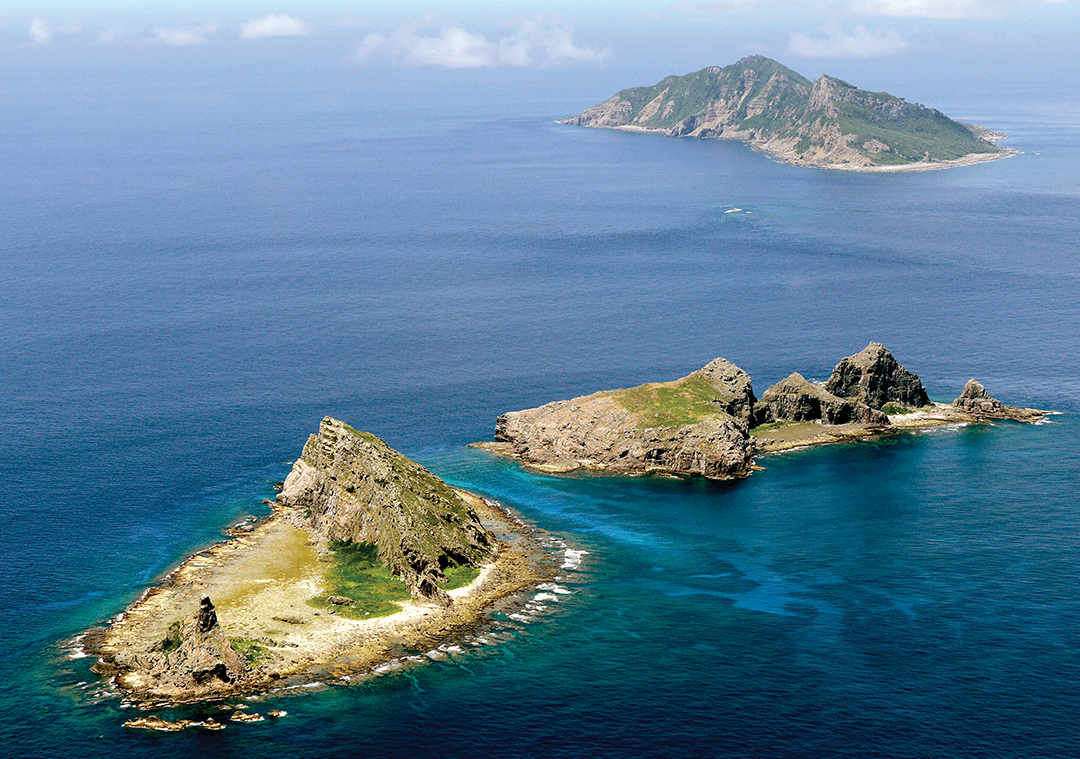Sea Claims and Shifting tides

China’s changing relationships and inconsistent practices reveal questionable motives
China has aggressively laid claims to land in the South China Sea since August 2014. Satellite imagery reveals that China has built new islands on several reefs in the Spratly Islands, including Fiery Cross Reef, Gaven Reefs, Johnson South Reef and Hughes Reef, according to reports by IHS Jane’s Defence Weekly.
At Fiery Cross Reef, the most extensive project, China began building a 3,000-meter-long and roughly 250-meter-wide island, large enough to support an airstrip, as Jane’s reported in November 2014. The reef was previously submerged.
Images in March 2015 also revealed that China had begun building its first airstrip on the reef, Reuters reported. Images provided to IHS Jane’s Defense Weekly by Airbus Defence and Space showed a paved section of runway measuring 505 meters by 53 meters. Moreover, the Chinese started reclaiming an area on Subu Reef in the Spratlys that could also accommodate an airstrip, Reuters said.
Although other countries, including Malaysia and Vietnam, have built on or modified similar existing land masses over the years, China’s activities have substantially changed the size and structure of physical land features, according to Mira Rapp-Hooper, director of the Asia Maritime Transparency Initiative and a fellow with the Asia Program at the Center for Strategic and International Studies. “Until its work on Fiery Cross, China was the only major Spratlys claimant without an airstrip. What sets China’s activities apart, however, is that Beijing has been dramatically changing the size and structure of physical land features, while other claimants have built upon or modified existing land masses.”
China’s endeavor “is a methodical, well-planned campaign to create a chain of air and sea capable fortresses across the center of the Spratly Islands chain,” Jane’s Asia Pacific editor James Hardy told The Wall Street Journal newspaper.
This so-called assertive expansionism seems to be the latest example of the apparent misalignment between China’s words and actions, as the nation intensifies its drive to reinforce its strategic position as a security provider in the region and strengthen its positions in various disputed territories. Such inconsistencies may be generating fear and uncertainty in the Indo-Asia-Pacific region, some analysts worry.
During 2014, for example, China signed a flurry of agreements with Bangladesh to foster economic, strategic and other ties and moved to do the same with other countries and members of the Association of Southeast Asian Nations (ASEAN). Although most countries — including the U.S., India, South Korea, Vietnam, Australia and Japan — welcome increased bilateral trade with China, some countries are beginning to question some of China’s intentions and inconsistencies in its quest to quickly spread its influence. Besides its activities in the Spratlys, China appears to be fostering intelligence and military links by financing and supporting a network of ports in Pakistan, Sri Lanka, the Maldives, Bangladesh and Burma. It has also built railways through Tibet near Sikkim that seem to create a logistical military access to India’s border, according to The New Indian Express newspaper. Moreover, China seems to have provoked nations that it has ongoing territorial disputes with. In early May 2014, for example, China deployed an oil rig in Vietnam’s economic zone near islands claimed by both nations and then removed it in mid-July that year.
All the while, China has been stating publicly that it wants a “new style of great power relations” with the U.S. and other great powers. China says it promotes a peaceful and integrated periphery. China says it seeks to enhance stability, peace and prosperity while it rises.
Several of China’s foreign policy actions undermine these objectives, generating mistrust of Chinese intentions and fear of Chinese manipulation among China’s neighbors. In April 2015, President Barack Obama said China was employing its “sheer size and muscle” to push other smaller Asian nations around and cautioned about militarizing the disputed islands, Reuters reported.
Cui Tiankai, China’s ambassador to the U.S., claimed it was “natural” for the construction to include military defense facilities, according to Reuters. “There should be no illusion that anyone could impose on China a unilateral status quo” or “repeatedly violate China’s sovereignty without consequences.”
Despite this inconsistency, regional nations see few options but to hedge their bets between the U.S. and China. Indeed, the region already appears to be embroiled in a security dilemma. China must directly address the inconsistencies between its rhetoric and actions, clarify its intentions, and take steps to address the concerns of regional nations. Failing to do so not only increases regional instability but also undermines opportunities for political and economic cooperation.
The new type of great power relations (NTGPR) promoted by President Xi Jinping offers a framework for ensuring that China’s ongoing development does not generate undue friction with other powerful nations in the Indo Asia Pacific. While the framework applies to China’s relations with all powerful countries (including Japan, Russia and India), the Chinese overwhelmingly focus NTGPR on the U.S.-China relationship.

China offers three main means through which NTGPR reduces U.S.-China friction, according to a 2013 report by the National Bureau of Asian Research. First, NTGPR seeks to avoid conflict by emphasizing dialogue and clearly communicating each side’s strategic objectives. Second, it dictates mutual respect for each side’s national interests and concerns. Finally, each side should seek out areas of mutual interest that can be pursued cooperatively. These are three laudable goals, but Chinese actions consistently undermine them.
China routinely marginalizes U.S. interests and concerns in the Indo Asia Pacific. This is especially true regarding international law and territorial dispute resolution. China’s nine-dash line claim to territory in the South China Sea is not only ambiguous but does not appear to conform to the rules of the U.N. Convention on the Law of the Sea, according to a 2014 U.S. State Department report. China has not explained precisely what it is claiming: land, water, sovereignty or exclusive economic zones, demarcated at any specific coordinates. Even though China’s territorial disputes are not directly with the U.S., the U.S. has always been closely concerned with international law, and upholding it remains an American national interest. When the U.S. does express concern over Chinese actions in this regard, China admonished the U.S. not to get involved in territorial disputes in the South China Sea. “The United States, Japan and Australia are allies, but this should not become an excuse to interfere in territorial disputes, otherwise it will only make the problems more complicated and harm the interest of all parties,” a Chinese Foreign Ministry spokeswoman said on the ministry website in October 2013. “We urge the relevant countries to respect the facts, distinguish right from wrong, be cautious, and stop all words and deeds that are not beneficial to the proper handling of the issue and undermine regional stability.”
This despite Xi indicating the U.S. is a Pacific nation with real security interests in Asia. “China and the U.S. should continue to enhance dialogue and coordination on Asia Pacific affairs, and respect and accommodate each other’s interests and concerns in the region, and develop inclusive coordination,” he said during a joint news conference with U.S. President Barack Obama in November 2014.
Furthermore, some of China’s territorial disputes involve U.S. treaty allies Japan and the Philippines. While the U.S. takes no official position on which nation owns what territory, the manner in which these disputes are resolved is of deep strategic concern to the U.S.
The Chinese military seems to be testing many nations. China antagonized Japan in the East China Sea in 2013 and 2014 by increasing patrols of its growing Coast Guard around the cluster of contested islands, known in Japan as Senkaku and in China as Diaoyu. In 2012, China seized Scarborough Shoal from the Philippines and in May 2014 interfered with Philippine ships reaching the Second Thomas Shoal.
Such actions by China toward Japan and the Philippines often appear to take the form of thinly veiled military pressure and coercion. Xi and Prime Minister Shinzo Abe of Japan did meet in Beijing in November 2014 to recognize their different positions on the East China Sea, among other things, according to a report in The New York Times newspaper. The safety of its allies remains a core U.S. national interest, and any potential threat to U.S. treaty allies is treated with the gravest concern.

In addition to the NTGPR, at an October 2013 Chinese Communist Party work forum, Xi said one of China’s foreign policy goals is a peaceful and integrated community of nations along its geographic periphery. The Chinese State Council’s 2011 white paper “China’s Peaceful Development” also states that China seeks to enhance stability, peace and prosperity in the region. However, Chinese actions again appear to undermine these stated goals, especially in the South China Sea.
Such actions seem to contrast China’s own policies to establish a stable and integrated region around its periphery. China’s New Silk Road and New Maritime Silk Road policies seek to further enhance and expand China’s sphere of influence by creating a stable, integrated, and prosperous political and economic environment conducive to China’s stated NTGPR framework, according to an analysis published in the Hoover Institution journal Chinese Leadership Monitor by China and East Asian expert Michael Swaine, a senior associate at the Carnegie Endowment for International Peace. Southeast Asia is part of that periphery and incorporating Southeast Asian nations into these policies will be crucial to their success. However, several Southeast Asian nations claim the very areas in the South China Sea on which China is building military bases. Constructing artificial islands and building military bases in disputed territory can only increase political tensions and instability in the region, according to a communique released by the Philippines and Vietnam on January 30, 2015. The communique’s focus was to express deep concern “over the ongoing massive land reclamation activities that pose threats to the peace and stability in the region as well as to the lives of many people across the various coastal states,” The Diplomat magazine reported in March 2015.

As China may come to find, no amount of economic incentives will convince the people of the Indo Asia Pacific to look the other way while China builds Navy and Air Force bases on territory that they claim. South China Sea nations may begin to reject Chinese regional economic plans until China addresses their political concerns. As the agreement between Vietnam and the Philippines shows, these nations view building military bases in disputed territory as coercion, pure and simple. If China does not change course, they may soon reject programs such as the New Silk Road and New Maritime Silk Road.
Course for stability
So what could China do to address the concerns of its Indo-Asian-Pacific neighbors? A first step could be to follow point No. 1 from the NTGPR: Emphasize dialogue and clearly communicate strategic objectives. If China is serious about accomplishing its stated objectives of promoting regional stability, prosperity and cooperation, then outlining Chinese views and objectives diplomatically should not be a problem. By clearly and precisely outlining its desires, especially concerning territorial claims, China can mitigate regional angst about its actions.
Pursuant to that, China could demonstrate how Chinese policies support regional stability, prosperity and cooperation. If China has a clear plan for how its actions in the South and East China seas promote its stated goals, then it should share that rationale with the other nations of the Indo Asia Pacific. Even if China’s neighbors disagree with the Chinese assessment, directly engaging on the subject will allow all parties to increase mutual understanding and address disagreements in a meaningful way. If Indo-Asian-Pacific nations are talking past one another, it is important to realize that and take actions to rectify it as soon as possible to avoid potential conflicts.

China might also take more concrete steps to demonstrate Chinese benevolent and stabilizing intentions. To be meaningful, these steps must directly relate to regional points of concern. For example, China should offer exact demarcation coordinates for its nine-dash line in the South China Sea and supplement this with an exact description of the contents of that claim (land, sovereign seas and exclusive economic zone). This would allow other disputant parties to clearly understand what China claims, helping to diminish their fears of manipulation.
Another more ambitious step would be to freeze the construction of military installations in the South China Sea. China’s ongoing construction efforts there are some of the leading drivers of regional instability. Freezing construction to allow for dialogue would go a long way in calming nerves. Additionally, due to the nature of the multiple overlapping claims in the South China Sea, diplomatic dialogue could be between China and ASEAN. That could allow concerned parties the opportunity to exchange views in a dynamic and effective way.
Aligning actions and words
The gap between China’s stated intent and actual conduct is generating instability in the Indo Asia Pacific. China claims to seek peace, stability and prosperity in the region. However, Chinese actions in the political and security realms seem to undermine these goals.
Perhaps China has a coherent plan for how it believes this seeming contradiction can unfold harmoniously, but until it demonstrates that to the region, regional insecurity and instability may well continue to grow. If China cannot address the political and security concerns of its neighbors, then its economic, political and security aspirations may all fail.





